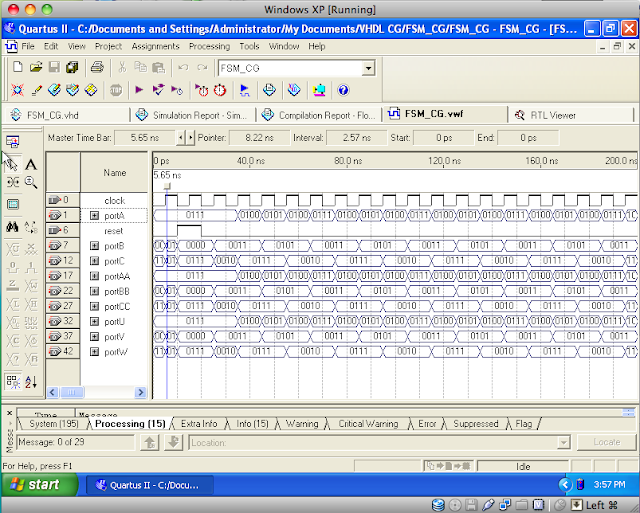LUT_MUL_BR_CG.vhdl
library ieee;
use ieee.std_logic_1164.all;
use IEEE.std_logic_arith.all;
use IEEE.std_logic_unsigned.all;
entity LUT_MUL_BR_CG is
port (
clk0 : in std_logic;
x, y: in std_logic_vector(3 downto 0);
z: out std_logic_vector(3 downto 0);
portu, portv, portw: out std_logic_vector(3 downto 0);
porta, portb, portc: out std_logic_vector(3 downto 0)
);
end LUT_MUL_BR_CG;
architecture rtl of LUT_MUL_BR_CG is
component LUT_BR
port (
clk : in std_logic;
a, b: in std_logic_vector(3 downto 0);
c: out std_logic_vector(3 downto 0);
porta, portb, portc: out std_logic_vector(3 downto 0)
);
end component;
signal u : std_logic_vector(3 downto 0);
signal v : std_logic_vector(3 downto 0);
signal w : std_logic_vector(3 downto 0);
begin
u <= x;
v <= y;
lutmul: lut_br port map(clk0, u, v, w, porta, portb, portc);
z <= w;
portu <= u;
portv <= v;
portw <= w; end rtl;
LUT_BR.vhdl
library ieee;
use ieee.std_logic_1164.all;
use ieee.std_logic_arith.all;
use ieee.std_logic_unsigned.all;
entity LUT_BR is
port (
clk: in std_logic;
a, b: in std_logic_vector(3 downto 0);
c: buffer std_logic_vector(3 downto 0);
porta, portb, portk, portc: out std_logic_vector(3 downto 0)
);
end entity LUT_BR;
architecture behavioral of LUT_BR is
component adder_mod_m_CG
port (
x, y: in std_logic_vector(3 downto 0);
addb_sub: in std_logic;
z: buffer std_logic_vector(3 downto 0)
);
end component;
signal z : std_logic := ‘0’;
signal i : std_logic_vector(3 downto 0);
signal j : std_logic_vector(3 downto 0);
signal k : std_logic_vector(3 downto 0);
begin
process(clk)
begin
if clk’event and clk = ‘1’ then
case a is
when "0001" => i <= "0000";
when "0010" => i <= "0001";
when "0011" => i <= "0011";
when "0100" => i <= "0010";
when "0101" => i <= "0110";
when "0110" => i <= "0100";
when "0111" => i <= "0101";
when others => i <= "0000";
end case;
case b is
when "0001" => j <= "0000";
when "0010" => j <= "0001";
when "0011" => j <= "0011";
when "0100" => j <= "0010";
when "0101" => j <= "0110";
when "0110" => j <= "0100";
when "0111" => j <= "0101";
when others => j <= "0000";
end case;
case k is
when "0000" => c <= "0001";
when "0001" => c <= "0010";
when "0010" => c <= "0100";
when "0011" => c <= "0011";
when "0100" => c <= "0110";
when "0101" => c <= "0111";
when "0110" => c <= "0101";
when others => c <= "0000";
end case;
end if;
end process;
porta <= a;
portb <= b;
portk <= k;
portc <= c;
adderku: adder_mod_m_CG port map (i, j, z, k);
end architecture behavioral;
add_mod_m_CG.vhdl
library ieee;
use ieee.std_logic_1164.all;
use IEEE.std_logic_arith.all;
use IEEE.std_logic_unsigned.all;
entity adder_mod_m_CG is
port (
x, y: in std_logic_vector(3 downto 0);
addb_sub: in std_logic;
z: out std_logic_vector(3 downto 0)
);
end adder_mod_m_CG;
architecture rtl of adder_mod_m_CG is
constant M: std_logic_vector(3 downto 0) := conv_std_logic_vector(7, 4);
signal long_x, xor_y, sum1, long_z1, xor_m, sum2: std_logic_vector(4 downto 0);
signal c1, c2, sel: std_logic;
signal z1, z2: std_logic_vector(3 downto 0);
begin
long_x <= ‘0’ & x;
xor_gates1: for i in 0 to 3 generate
xor_y(i) <= y(i) xor addb_sub;
end generate;
xor_y(4) <= ‘0’;
sum1 <= addb_sub + long_x + xor_y;
c1 <= sum1(4);
z1 <= sum1(3 downto 0);
long_z1 <= ‘0’ & z1;
xor_gates2: for i in 0 to 3 generate
xor_m(i) <= m(i) xor not(addb_sub);
end generate;
xor_m(4) <= ‘0’;
sum2 <= not(addb_sub) + long_z1 + xor_m;
c2 <= sum2(4);
z2 <= sum2(3 downto 0);
sel <= (not(addb_sub) and (c1 or c2)) or (addb_sub and not(c1));
with sel select z <= z1 when ‘0’, z2 when others;
end rtl;


















Reply